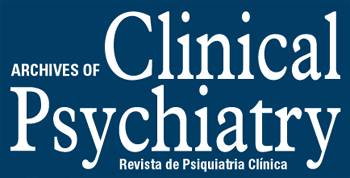Abstract
Based on a case of an acute and transient psychotic disorder with full recovery between recurrences, the authors remind the concept of cycloid psychoses. This diagnosis has been neglected in modern psychiatry and in the current nosological systems. However, the cycloid psychoses concept may offer an alternative diagnosis for some psychotic disorders in spite of the need of more studies to improve the understanding of its etiology and treatment.
Psychopathology; psychoses; schizophrenia
Introduction
Cycloid psychoses are characterized by polymorphic symptomatology with intraphasic bipolarity, a remitting and recurrent course and favorable prognosis1,2. Despite its clinical relevance, the cycloid psychoses concept has been relatively neglected in current psychiatric nosological systems2.
Case report
Mr. F is a 32 year old, single man. He had no past medical history or known familial disease. The patient has a history of five previous psychiatric hospitalizations, having been the first at age of nineteen. The second and third admissions were at his 25 years old and the fourth and fifth admissions at his thirties. He was psychopathologically compensated in the periods between admissions.
The clinical pictures that motivated these five hospitalizations have some similarities, namely the acute onset (two or three days until the installation of the full clinical picture), the presence of auditory hallucinatory activity in the form of voices, delusional persecutory ideation, neutral mood, insomnia, anxiety, mutism, agitation and increased reactive motions.
At the first-episode psychosis the analytical and imagiological investigation was negative and included laboratory studies (blood count, biochemistry and thyroid function), serological tests (hepatitis B and C, syphilis and HIV), toxicology screen, head CT and EEG. In all hospitalizations, abuse of substances and medical conditions that could justify the existing symptoms were excluded.
All relapses had a sudden onset and only in the first episode was described a major trigger factor (cousin’s death on a car crash).
In the psychiatric unit, the patient was medicated with antipsychotics in therapeutic doses (olanzapine 15 mg/day in the first hospitalization and amisulpride 400 mg/day in the others four admissions) and a benzodiazepine (lorazepam 2,5 mg three times a day) for control of anxiety and insomnia.
During the admissions, motor symptoms described showed rapid fluctuations between the two opposite poles (agitation/inhibition) and the clinical picture have a rapid improvement in few days with high-dose antipsychotic therapy with complete remission within a week. Thus, patient returned to his normal life, fully functional as previously without evidence of deterioration (normal Mini Mental State Examination score).
In the maintenance phases of the disease, the patient was treated with low doses of antipsychotic (amisulpride 200 mg/day) and lorazepam 2.5 mg/day, except during the gap between the first and second hospitalization, when clinical diagnosis was not clear and therefore he was treated with olanzapine 15 mg/day.
Currently, the patient is clinically stabilized and no relapses had place since about two years.
Discussion
The case described close up of the category of acute and transient psychotic disorder in ICD-10 or of the brief psychotic disorder in DSM-5, based on duration criteria.
For the differential diagnosis are important two clinical aspects: absence of altered mood (exclusion of bipolar disorders) and time course of each episode less than one month (exclusion of schizophreniform disorder).
However, this clinical case is more complex with clinical peculiarities that classification systems do not highlight, such as, the mixture of psychotic, anxious and psychomotor symptoms, the intraphasic bipolarity and the cyclic course with rapid and full recovery.
The clinical case described would be better diagnosed using the concept of cycloid psychoses and it seems to be approaching the Kleist-Leonhard’s subtype “hyperkinetic-akinetic motility psychoses”, once the psychomotor activity is most affected.
In what concerns to treatment, the pharmacological intervention with atypical neuroleptics seems to be effective in the remission of the acute episode but its potential to prevent relapse is unclear2. Other therapeutic approaches referred in the literature are related with electroconvulsive therapy and lithium3.
Given the lack of studies, the empirical evidence suggests that prophylactic treatment with lithium or anticonvulsive agents may be superior to neuroleptic theraphy3. However, some cases reported suggest that the cycloid psychoses may not require long-term maintenance pharmacological treatment2.
In fact, the cycloid psychoses concept can be an alternative diagnosis for some psychotic disorders. However, more research is needed towards better understanding the role of somatic factors that might trigger the psychoses and the efficacy (acute phase and prophylaxis) of neuroleptics agents, benzodiazepines, anticonvulsive agents and electroconvulsive therapy3.
References
- 1Van de Kerkhof NWA, Van der Heijden FMMA, Schneider MKF, Pfuhlmann B, Stöber G, Egger JIM, et al. Cycloid psychoses: Leonhard’s descriptions revisited. Eur J Psychiat. 2012;26(4):266-78.
- 2Salvatore P, Bhuvaneswar C, Ebert D, Maggini C, Baldessarini RJ. Cycloid psychoses revisited: case reports, literature review, and commentary. Harv Rev Psychiatry. 2008;16(3):167-80.
- 3Jabs BE, Pfuhlmann B, Bartsch AJ, Cetkovich-Bakmas MG, Stöber G. Cycloid psychoses – from clinical concepts to biological foundations. J Neural Transm. 2002;109(5-6):907-19.
-
Funding: There was no funding for this work.
Publication Dates
-
Publication in this collection
May-Jun 2015
History
-
Received
29 Mar 2015 -
Accepted
5 May 2015

 A case of cycloid psychotic disorder
A case of cycloid psychotic disorder